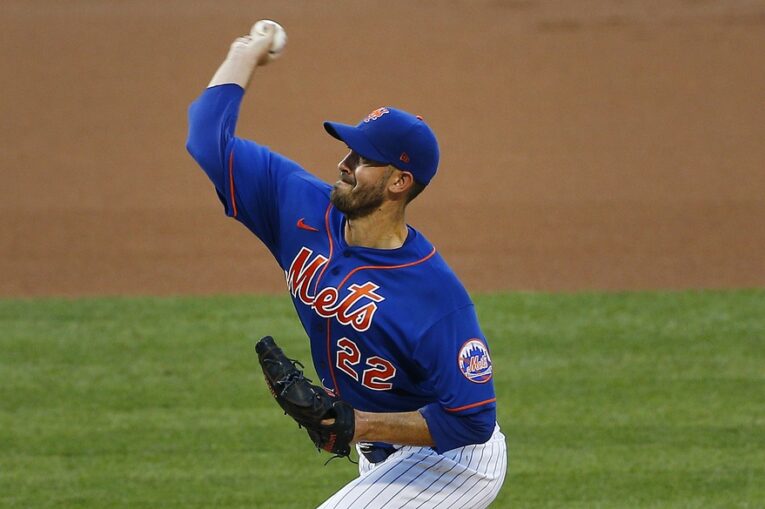
The first 19 innings of Rick Porcello’s New York Mets career hasn’t exactly been sunshine rainbows, which is a recurring theme for this organization thus far in 2020. On the bright side, though, it could be a lot worse for the veteran righty.
Porcello is 1-2 with a 5.68 ERA, 1.63 WHIP, 17.9% strikeout rate, and 7.1% walk rate. These numbers were only possible because of what he’s done through his last two turns in the rotation. Let’s not forget that after his first two starts, he was sarcastically joking that simply getting past the second inning was an accomplishment as he sported an unsightly 13.50 ERA.
While it still remains to be seen if what he’s done recently can be sustained over the next month-and-half, Porcello has easily done an about-face with regard to his production. He’s actually gone deep into games, limited scoring (2.08 ERA over his last two starts), and although the Mets are just 1-1 during this time, all the blame for taking an L can be hung on the offense not getting the job done.
Pitching is hardly a simple task in general, let alone at the big league level. However, there’s one area of Porcello’s game that sticks out the most when comparing his first two starts with his last two.
The One Big Change
Alright, I won’t leave you in suspense: Porcello has found a way to get his control… under control.
If we take a look at what he’s done on a start-by-start basis, the righty’s walk rate has gone down drastically each time he’s taken the mound. His walk rate settled in at 20.0% in that unfortunate debut against the Atlanta Braves on Sunday Night Baseball. His next time out was better, but still not great with a 14.3% walk rate. His last two starts? Porcello hasn’t walked a single batter.
It’s a lot easier to not allow walks when you’re working ahead in the count more frequently, like Porcello has been. His first-pitch strike rate sat at 50.0% through two starts but has risen dramatically to 70.8% over his last two outings.
These things obviously have a domino effect in other areas, like his strand rate. When there are fewer base runners to worry about, it gets easier to prevent them from scoring. Less stress is a good thing, although it’s hard for us Mets fans to really know what that’s like.
Porcello’s strand rate has improved drastically over his first four starts in New York — going from 30.0% to 50.0% to 80.0% to 90.9%.
Other Things That Have Helped
Being more economical with his pitches and using the good defenders Luis Rojas has penciled in on the nights Porcello pitches has brought favorable outcomes. Focusing on getting ahead and taking control of at-bats with opposing hitters has also allowed the righty to have more flexibility in attacking the zone more frequently.
After all, it’s easier for a pitcher to utilize their entire arsenal when they don’t have to worry about catching up. Getting ahead has made his breaking pitches more effective — opposing hitters have watched their chase rate jump from 23.5% to 34.0% over the two periods of time we’ve been discussing. The quality of contact has basically stayed identical, which isn’t optimal because Porcello is allowing hard contact at nearly a 50.0% clip.
However, the types of batted-ball events he’s been inducing has changed, making it easier for the defense behind him — cough, Andres Gimenez, cough — do their thing.

Without the stress of always trying to put his breaking pitches in the strike zone, the value of these offerings have improved, too.

So, something as simple as throwing strikes had an immediate impact on Porcello’s performance. Just crazy, isn’t it?
Moving Forward
We’ve seen two very different sides of Porcello through just a couple weeks. One was a dude who could barely get through four innings, and the other has twirled consecutive quality starts while allowing a total of three runs in 13 innings.
Which one will the Mets get moving forward? The second version would be nice. However, since Porcello isn’t a huge swing-and-miss guy, that may be dependent on the defensive alignment behind him when he does take the mound. It’s fair to say these two versions are both ends of the spectrum, and something in the middle is more what New York was expecting in the first place when Porcello signed during the offseason.
With a rotation suddenly in flux because of injury (Michael Wacha), underperformance (Steven Matz), and an opt out (Marcus Stroman), it’s crucial that the good and strike-throwing version of Porcello continues showing up to pitch every fifth day through the end of September.














